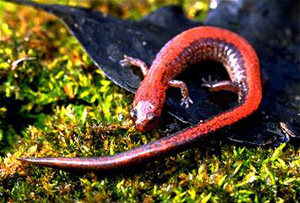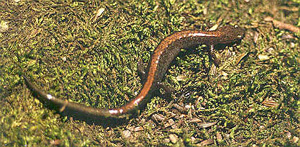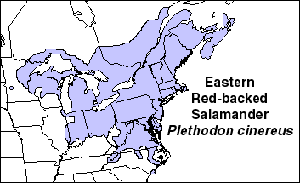Eastern Red-backed Salamander - Plethodon cinereus
The Red-backed Salamander is the most commonly encountered salamander throughout most of its range. The Red-backed Salamander is characterized by the red stripe which begins immediately behind the head and extends nearly to the tip of the tail. The red stripe is usually very straight throughout its entire length along the body and generally covers the entire back of the salamander. In some populations the red color of the stripe is replaced by dark gray (above right). This is called the lead-backed phase. The belly is finely mottled with equal amounts of white and black creating a "salt and pepper" effect. Red-backed salamanders have 16 to 19 grooves on their sides. They have no circular constriction at the base of their tails, and they have five toes on their hind feet and four toes on their front feet. Males and females look the same.
The Red-backed Salamander along with all salamanders within the family Plethodontidae are lungless. Nearly all of their respiration takes place through cutaneous gas exchange. This means that they breathe through their skin. The remaining gas exchange takes place through buccopharyngeal (within the mouth) respiration. Unlike most salamanders, Red-backs do not spend any part of their lives in the water. They are completely terrestrial (though dependent upon moisture). (Note that these salamanders sometimes lose portions of their tails during encounters with predators).
Average Size - Red-backed normally reach a length between 2 1/2" to 5 "
Life Span - Red-backed salamanders can live for several years, in some cases up to 10 years.
Diet - Red-backed salamanders feed on a large variety of invertebrates. These include mites, spiders, insects, centipedes, millipedes, beetles, snails, ants, earthworms, flies, and larvae. They forage by thrusting out their tongue in a quick, forward motion to capture their prey.
Feeding Red-backed salamanders do not have to be fed every day - every other day or every three days is often enough. It may take a little experimentation to figure out how much and how often they should be fed, but you can try to judge by their growth and body condition (fat or skinny) and whether excess food is being left (which will cause toxins to build up in the tank).
Humidity - Keep a somewhat humid environment. Humidity levels of 60 – 70% are fine. Misting several times a day and fully soaking plants and substrate should provide enough humidity. Watch for fungus, molds, etc. – these should not be allowed to stay. Red-backed salamanders must have moist skin, it is very important that the humidity and moisture levels be maintained
Substrate - Loosely packed soil with partially buried "logs" and rocks to help break up the soil and allow the red-backed salamander to burrow will work
Habitat - A 20 gallon tank will hold maybe 2 - 4 animals amphibians. Red-backed salamanders, like other herps, will gladly wonder off if given the chance, so your cage will need a secure top. The tank must be kept moist - the red-backed salamander will spend much of its time under rocks, logs or just buried in the soil.
Temperature - Perhaps the most convenient part of red-backed salamander as with red spotted newt keeping is the fact that virtually all species can be kept at room temperature or even cooler. No special heating is required. The ideal temperature for newts is about 60 – 65 degrees F. In the spring when the breeding season rolls around, you will have to raise the temperature a bit, which can be done naturally if you live in an area where the seasons are well defined. If you wish to hibernate keep them at about 40 degrees Fahrenheit for a few weeks and them warm them up slowly when you re ready to bring them back out – this can also help facilitate breeding.
 Lighting - In the wild, red-backed salamanders are active during both day and night, depending on weather conditions. Lighting - In the wild, red-backed salamanders are active during both day and night, depending on weather conditions.
Water - red-backed salamanders don't need special water needs - they derive all their water needs from the humidity and moisture in the terrarium.
Normal Behavior and Interaction - They are relatively solitary and defend small territories in which they feed. Red-backed Salamanders protect their limited food supply by marking out territories. This behavior occurs most often when moisture levels are low and the salamanders have to hide under logs or rocks. Both males and females leave scent marks on the ground as well as leaving their droppings. Other salamanders can learn a lot from these clues. They learn each others territorial boundaries, the size and importance of the salamanders that live in the area, and their identity, including whether or not they are related. When finding food is very hard due to dry conditions, adults who have their own territories will sometimes allow young salamanders that are related to them to use their territories. Intruders are also warned away by seeing the size of the salamander and watching it give threatening displays.
Red-backed salamanders come out from their hiding places at night after a rain. This is when they do most of their hunting. Red-backed salamanders can survive these times with little food because they are pulse feeders, which means they eat large amounts when conditions are good and store the extra nourishment as fat to live off of when conditions are bad.
Recommended Supplies:
- Habitat with secure lid
- Thermometer
- Light Timer
- Book on salamanders
- Substrate - potting soil, leaf litter
|
- Driftwood
- Incandescent light
- Ceramic heater
- Mister - or at a minimum a spray bottle
| Habitat Maintenance Change water daily. Thoroughly clean the tank at least once week: set salamander aside in a secure habitat; scrub the tank and furnishings with a 3% bleach solution; rinse thoroughly with water, removing all smell of bleach; dry the tank and furnishings; and add clean substrate
Grooming and Hygiene When cleaning housing, check salamander for any abrasions, signs of parasites or or fungal infections. Always wash your hands before and after touching your newt or habitat contents to help prevent Salmonella and other infectious diseases
Range - Red-backed salamanders are native to the Nearctic (temperate) region only. They live in Eastern  North America. Their range extends west to Missouri; south to North Carolina; and north from southern Quebec and the Maritime Provinces in Canada to Minnesota. They are most common in areas of appropriate habitat throughout the midwestern United States. Red-backed salamanders are found in deciduous forests throughout their range. They live in fallen leaves as well as under rocks, logs, or in small burrows. When disturbed, they will crawl into tunnels or under leaves. North America. Their range extends west to Missouri; south to North Carolina; and north from southern Quebec and the Maritime Provinces in Canada to Minnesota. They are most common in areas of appropriate habitat throughout the midwestern United States. Red-backed salamanders are found in deciduous forests throughout their range. They live in fallen leaves as well as under rocks, logs, or in small burrows. When disturbed, they will crawl into tunnels or under leaves.
Like many other amphibians, salamanders can be hurt by high levels of acidity. Red-backed salamanders respond the same way to acidic surroundings as amphibian larvae do when exposed to acidic water, their sodium balance is disrupted. They are rarely found on soils with a pH of 3.7 or lower.
Breeding - Red-backed salamanders mate in the fall but the female does not lay her 3 to 14 eggs until the following spring. The eggs are laid in a cluster in naturally occurring cracks and crevices. Eggs can also be laid in or under rotting wood. The mother wraps her body around the egg cluster until they hatch. The baby salamanders come out of the eggs looking like small adults. Upon emerging from the egg, young salamanders are independent. Salamanders recognize their relatives through smell and although they are solitary, mothers will allow their young to stay in her foraging area. Female salamanders mate every other year.
Red-backed salamanders make up an important food source for a wide variety of snakes, birds, and mammals. They have the ability to drop all or part of their tail if under attack from a predator and can grow a new one afterwards. The tail that grows back is often lighter in color than the original tail.
Red-backed salamanders play an important biological role in both providing food for their predators as well as consuming large numbers of invertebrates.
Signs of a Healthy Pet:
- Clear eyes
- Clear nose and mouth
- Active and alert
|
- Eats regularly
- Healthy skin
|
Common Health Issues and Red Flags:
- Vomiting
- Discharge in nose or mouth
- Lethargy
|
- Abnormal feces
- Decreased appetite
- Cloudy eyes
|
If you notice any of these signs, please contact your exotic animal veterinarian. As with all pets in this category, it is important that you find a veterinarian that practices in EXOTICS – this is critical. The typical small animal practitioner may not have sufficient knowledge in this area.
Even this guide is general in nature and should not be used to diagnose your pet.
|



 Lighting - In the wild, red-backed salamanders are active during both day and night, depending on weather conditions.
Lighting - In the wild, red-backed salamanders are active during both day and night, depending on weather conditions. North America. Their range extends west to Missouri; south to North Carolina; and north from southern Quebec and the Maritime Provinces in Canada to Minnesota. They are most common in areas of appropriate habitat throughout the midwestern United States. Red-backed salamanders are found in deciduous forests throughout their range. They live in fallen leaves as well as under rocks, logs, or in small burrows. When disturbed, they will crawl into tunnels or under leaves.
North America. Their range extends west to Missouri; south to North Carolina; and north from southern Quebec and the Maritime Provinces in Canada to Minnesota. They are most common in areas of appropriate habitat throughout the midwestern United States. Red-backed salamanders are found in deciduous forests throughout their range. They live in fallen leaves as well as under rocks, logs, or in small burrows. When disturbed, they will crawl into tunnels or under leaves.